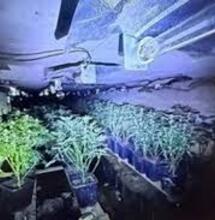Hydro Over Hand Watering: Part 2: Flood and Drain Technique

Think hydro is too complicated? How about a hydro system that lets you grow in pots, using any growing medium - even your favourite compost - and cuts down on your hard work? Our campaign for the fastest growth and the biggest yields continues with a look at flood and drain...
Think hydro is too complicated? How about a hydro system that lets you grow in pots, using any growing medium - even your favourite compost - and cuts down on your hard work? Our campaign for the fastest growth and the biggest yields continues with a look at flood and drain...
Think hydro is too complicated? How about a hydro system that lets you grow in pots, using any growing medium - even your favourite compost - and cuts down on your hard work? Our campaign for the fastest growth and the biggest yields continues with a look at flood and drain...
Last issue we took a good look at NFT (nutrient film technique) a hydroponic method that is classed as ‘pure hydroponics'. Although it is pretty simple to use, NFT and other ‘pure' hydro styles of growing do tend to scare off a lot of you growers. It's understandable that you do not want to give up the security of having a growing medium - be it compost, coco or clay - surrounding the roots of your precious plants; particularly when there are some tasty buds at risk!
| A Large Table System |
| The Low Level Table System |
This issue we look at a hydroponic technique that offers the faster growth cycles and bigger yields of active hydro, but has the flexibility to be used with coco or compost.
Ask yourself this question; when you first started growing, what technique did you first use? I am guessing that at least 90% of you out there started out by hand watering pots filled with compost. Fair enough, it is a great method for a beginner; compost is very forgiving and will buffer against pH fluctuations and over feeding. Plus, hand watering your plants every other day means you can concentrate on getting your environment right and - let's not forget - you can achieve a shit hot yield using compost!
But, what if I told you that there is a hydroponic technique out there that would have been great for your first grow - and all the grows that follow - where you can use compost and pots, reduce the amount of time you spend mixing feeds and watering AND shorten your growth cycle AND achieve bigger yields than hand watering??
Less work + A quicker crop + More buds at the end! Maybe you should have taken a look at flood and drain. Maybe it's time to take a look now.
What is flood and drain?
The principle of flood and drain is simple. A plant sit on a table or in a bucket and nutrient solution is pumped in from a reservoir and floods the table or bucket, when the pump turns off, the nutrient solution then drains away back into the reservoir. A timer is attached the pump and is used to set the frequency of the flood and drain periods.
During the flood period the roots of the plants are submerged which allows them to take up all the water and nutrients they need. All stale air is expelled from the root zone then, as the solution drains away, fresh oxygen is pulled back into the root zone. As the plants grow larger, the number of floods per day is increased.
The amount of nutrient solution used is easily measured and this allows experienced growers to tailor feeding schedules to get the optimum yields from their plants.
Flood and drain really is one of the most flexible hydro methods ever, because there is something for everyone. At its most simple, it can be a way to just keep your pots automatically watered, but for the more experienced grower it is the method that offers the most amount of choice as you can amend the number of flood periods per day and how long each period lasts. This way you can tailor the system to your own growing environment - because everyone's grow room has a different humidity, temperature and airflow - and get the maximum yield from you plants.
Who wouldn't be happy with that??
Why Flood and Drain over hand watering pots?
| The Inlet and Outlet Drains |
• Plants grow faster and yield more - plants take up more water and nutrients than they would with hand watering, feeding little and often throughout the day is healthier than giving one large feed every other day
• Root zone completely re-oxygenated several times a day - during the flood period, air is completely forced out of the root zone and fresh oxygen is pulled back in. Oxygenated roots mean a healthier plant that will grow quicker and yield much more than a hand watered plant
• Adjustability of the system - allows experienced growers to set the perfect feeding conditions for their specific growing environment, plus the ability to set variable feedings on a timer means you can set the optimum feeding schedule for specific strains
• No build up of nutrient salts - any nutrients not used by the plants just drains back into the reservoir, instead of building up at the bottom of the pot. A build up of nutrient salts will stunt growth as it causes certain nutrients to be ‘locked out'
Types of Flood and Drain System
| A Modular System |
There are two styles of flood and drain system, the table system and the modular or bucket system, both of them use the same technique and both have their own sets of benefits;
1. The Flood and Drain Table System
In a flood and drain system table plants sit on a table which is held above a nutrient solution reservoir. The table is usually flat with drainage running to the centre where there are two drainage fittings. One of the drainage fittings sits flush to the table - this is the inlet drain - the other will be around 10cm above the bottom of the table - this is the overflow drain.
The inlet drain is attached to the pump and the overflow drain just runs back into the reservoir. When the pump is turned ON, the nutrient solution is pumped into the table through the inlet drain. Eventually the level of nutrient solution will reach the level of the overflow drain and flow back into the reservoir. The overflow drain prevents the table from overflowing... just like the overflow drain in your bath tub! When the pump is turned OFF, the nutrient solution in the table drains back down the inlet drain, through the pump and back into the reservoir.
A timer is used to set the frequency at which, nutrient solution is pumped from the tank to flood the table and is then allowed to drain away. As the table floods, the plants take all the water and nutrients they need. All stale air is expelled from the root zone then, as the solution drains away, fresh oxygen is pulled back into root zone.
The benefits of the flood and drain table system are that you can grow your plants in any growing medium - soil, clay, coco or mapito. You can grow in pots and move the pots around the table if you need to or you can fill the whole table full of clay pebbles and allow the roots of the plants to spread across the whole of table - this is the method to go for if you are looking for the fastest growing and maximum yield.
Table systems are near enough leak proof, because the reservoir sits right underneath the table so there is nowhere for the nutrient solution to leak to - perfect if you are growing in an apartment or an attic! They also come in sizes that are ideasl for grow tents.
2. The modular or bucket flood and drain system
Similar to the table system in that it uses a timer to control the number of flood periods and benefits your plants by giving them doses of food and water throughout the day, combined with a highly oxygenated root zone. However, the main difference with the modular system is that each plant is placed in its own individual pot.
A supply tube runs from the bottom of each pot into a main control bucket, which in turn is connected to a main reservoir.
The system uses gravity to send nutrient solution to the pots and only uses pumps to fill and drain the main control bucket which has two magnetic float-valves mounted inside to control the power to the pumps in both the main reservoir and the controller bucket. These floats control the flood level in the pots precisely, to stop any over watering or flooding.
As the level of nutrient solution reaches a set level in the pots, the magnetic float valve in the main control bucket cuts the pump in the main reservoir OFF and turns a pump in the main control bucket ON. The pump in the main control bucket forces the nutrient solution out of the pots and back into the main reservoir.
The main benefits of the modular system are that you can space plants under lights however you like - so they can grow huge! - the systems are easy to upgrade by just adding more pots and you can run a big room full of plants from one single reservoir.
What type of grower is flood and drain good for?
As flood and drain systems are so flexible, they will benefit a real cross section of growers...
• New growers looking to grow in pots and keep their workload simple by maintaining a number of plants from one tank, so they can concentrate on maintaining their grow room environment.
• Experienced growers looking for an adjustable system to suit their individual growing environment and really maximise yield.
• Percy growers looking for a smaller scale system will do well with a flood and drain table system that fit nicely into a 1m square or 1.2m square tent, or one of the small sized modular flood and drain systems which are great for a two lamp set up.
• Large scale growers will really benefit from the modular flood and drain systems as they massively reduce the amount of time you spend watering your plants and they can be upgraded in size by just adding more pots. A smaller flood and drain table system can be used as a tidy vegging system to bring plants on under one or two lamps before transplanting to a large modular system.
The Three Steps to Flood and Drain Heaven!
1. Keeping a dedicated flood diary is the key to massive growth and yields when using flood and drain. Note down the number of floods per day compared to the amount of solution needed to top-up your system each day. The amount of solution that your plants use is directly related to their rate of growth, the idea is to maximise their consumption and maximise growth. By experimenting with the number and duration of floods, you will find the optimum number of floods for your growing environment.
2. Top up the reservoir depending on the growing medium that you are using. If you are using clay pebbles then treat the flood and drain as a re-circulating hydroponic system and top up the tank every few days with half strength nutrient solution. The reason that you use half strength is because plants grown under powerful lights will take up water at a greater rate than they take up nutrient. Over time the EC (CF) of the solution will rise, so if you top up with full strength solution you will run the risk of overfeeding. If using an absorbent medium, like soil or coco, the aim is to minimise run off and top up the tank with full strength nutrient solution. When growing in soil or coco, increase the number of flood periods by one additional flood per day, for example do not jump from three periods to six periods because you are growing in an absorbent growing medium and you can run the risk of water logging the roots of your plants or over feeding them.
3. Increase the number of flood periods and your plants get older and increase in size. When growing with just clay pebbles and your young plants first go into the system, set the timer to two 15 minute flood periods per day. As plants grow, you can increase the number of flood periods up to a maximum of one 15 minute feed per hour. You will need to perform a complete solution change every 1-2 weeks. When growing in soil or coco and young plants first go into the system set the timer to just one 15minute flood period per day. As plants grow, increase the number of feeds up to a maximum of four 15 minute feeds per day. When using an absorbent growing medium you should run the system to minimise run off and should only need to perform a complete nutrient solution change every 2 weeks or when the level of solution is running low.
Q&A with a Flood and Drain Grower
When can plants be transferred to a Flood and Drain system?
If you have started your plants in rockwool cubes or small pots of soil or coco, then ensure they are rootbound before you transfer them to a flood and drain system. You should be able to see lots of white roots on the outside of the starter medium.
If you are using a table system then you can veg and flower in the same system. If you are using the larger modular style flood and drain system then you may prefer to veg the plants under one or two lights before they go into the flower room as your modular system will most likely be spaced under several lights.
How should plants be spaced?
Depends how many you want to grow and how big you want to grow them. Table style systems are great for a sea of green grow, where are spaced close together and vegged until they form a low canopy. They are then switched to flower for a ‘sea' of buds!
The modular style flood and drain systems are perfect spacing out under several lights. You could choose to put four of the modular buckets under each light, or even just one bucket per light to grow some monsters! Modular flood and drain systems are tailor made for growing big, big plants. I once saw a system set up in a 20 lamp Californian grow room, where there was two plants per 1000w lamp and each plant had been vegged for eight weeks before being switched to flower. It was like a roomful of trees!
How high should EC be set?
If using an inert growing medium like clay pebbles, there is very little buffer (or protection) against overfeeding; so make sure you start to feed at half of the nutrient manufacturers recommended dosage. If you are using soil, coco or a mixture of clay and coco, then there is more of a buffer around the roots and you can start your plants at the nutrient manufacturers recommended dosage.
Will plants need to be supported?
Not necessarily. Unlike “pure hydroponic„ techniques such as NFT or aeroponics, there will be a growing medium surrounding the roots helping the plant support itself. However, as with all types of indoor grows, if your plants are putting out some big buds you will want to support them and stop them falling over!
So, whether you are a newbie or a green fingered expert, flood and drain has something to offer. Give it a go, you won't be disappointed and your plants will love you for it!!



